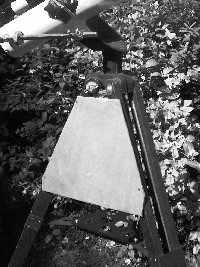This page last modified 2002 December 21
Upgrading a 60mm Refractor
The department-store incarnations of this telescope often leave a lot to be desired, but can usually be easily upgraded with the application of a little time.
The advice on this page is greatly expanded upon, with more pictures, in my book Astronomy with Small Telescopes
Eyepieces
Of the supplied eyepieces, generally the only one worth keeping is the weakest one, i.e. the one with the greatest number, usually 20mm or 25mm, on it. It is worth getting a decent quality high(ish)-power eyepiece such as a 9mm Orthoscopic. An alternative source of eyepieces is broken binoculars — the eyepieces are usually Kellners, but are sometimes Erfles on wide-field binoculars (identifiable by the unusually large eye lens).
If you have 24.5mm (0.965") eyepieces, you may wish to see if you can use standard (31.7mm - 1.25") eyepieces with a hybrid diagonal — the eyepieces will be usable if you upgrade later. You will not, however, be able to take advantage of the wider field of low power 1.25" eyepieces, because the 0.965" bit of the hybrid diagonal will cause vignetting. Also see below.
Barlow lens

The supplied Barlow is usually of poor quality, but the tubing can be cut
down to house eyepieces made from broken binoculars.
Sun Filter
If the telescope is suppled with an eyepiece-fitting Sun Filter, destroy it — they are dangerous and can break in use.
The Finder

If you have one of the 24mm finders, the simplest way to improve this is to
remove the optics and use the remaining tube as a sighting tube. alternatively,
remove the diaphragm that is just behind the objective lens. The resulting
finder image will be much more colourful, but also much brighter. Another
alternative is to push the diaphragm down the tube so that it acts as a field
stop — you will need to work out where this should be or, if you don't know
how to, justdo it by "trial and improvement".

If you want to replace the finder, either make one (junked binoculars
again), or get one good enough to use on the telescope you're saving up for.
Other options are to make simple "vee and blade" gunsight
arrangements, sighting tubes, or to make a simple unit-power finder .
Focuser
Some people suggest replacing the focuser with a 1.25" one, but this is not usually either simple or cost-effective. An alternative is to try a "hybrid" star diagonal, which will accept 1.25" eyepieces, but check that 1/25" eyepieces are able to be focused (sometimes they can, sometimes they can't).
If you are upgrading a little reflector, a 1.25" focuser is a viable option.
Mount

Ensure that all the bolts are kept tight. You can improve the stability by
suspending a weight (e.g a full water container) from the mount.
Tripod

Either make yourself another tripod (and another altazimuth mount whilst
you're at it), or cut some truncated triangles of thin plywood to fit between
the upper parts of the tripod legs and pin or tack them to the legs, so that the
result is like a triangular pyramid. The tripod no longer folds for storage, but
is much more stable.
Add a Chain

A two-foot length of heavy curb chain, taped to "big end" of the
telescope, will damp vibrations. .
What to do with it once you've replaced it
It can become your first guidescope once you have started doing guided astrophotography, or could store unobtrusively in a car so that you always have a telescope to hand should you need one.


